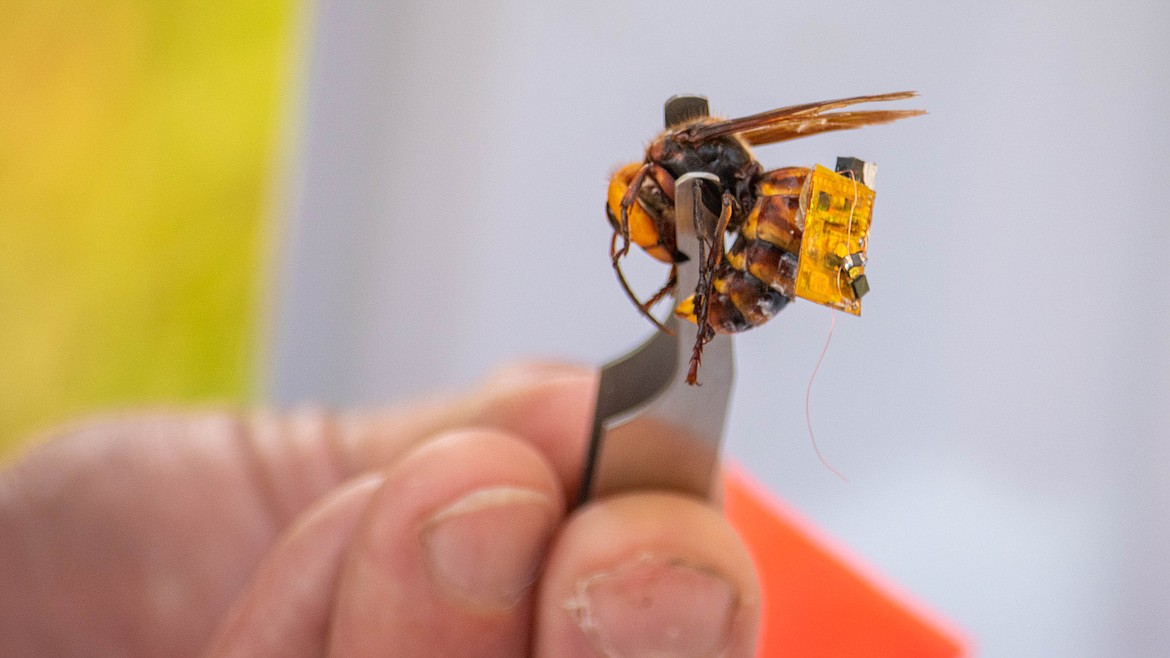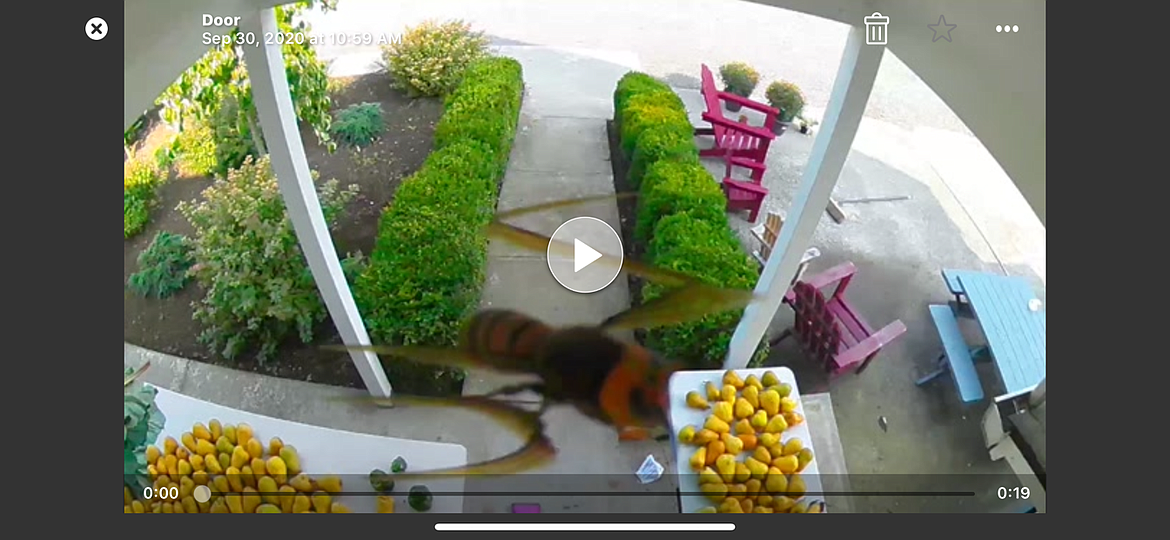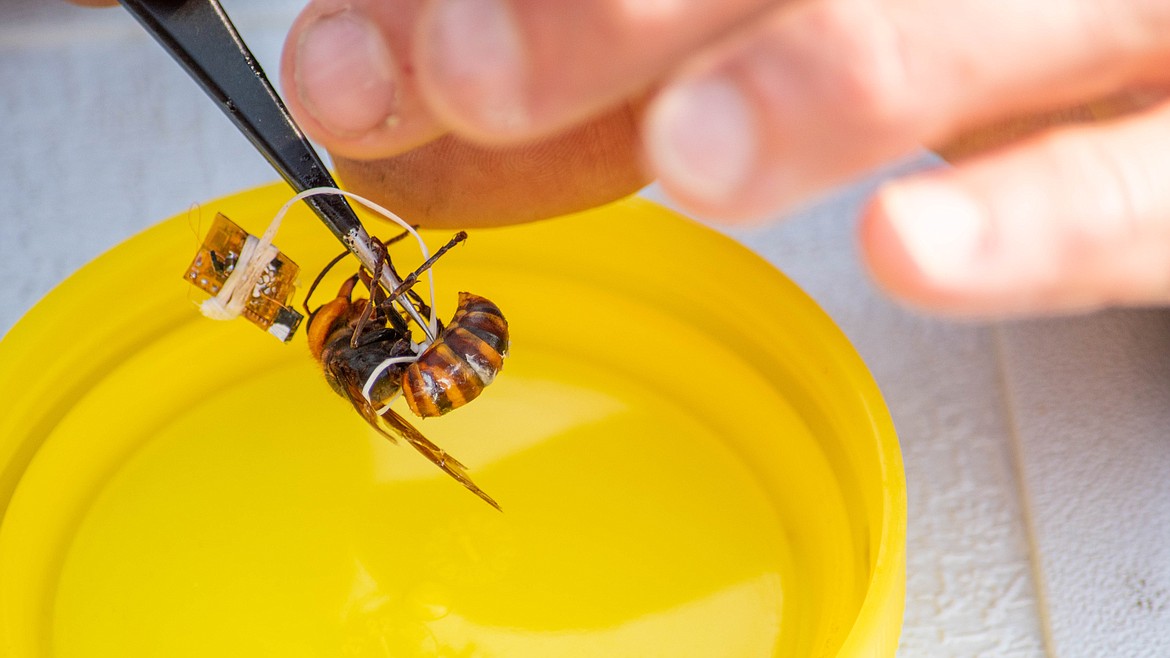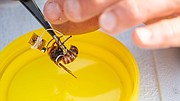WSDA catches, loses track of Asian giant hornet
OLYMPIA — The Washington State Department of Agriculture finally caught a live one!
An Asian giant hornet, that is, in early October, and WSDA was able to tag it with a tiny radio transmitter as well.
But WSDA quickly lost track of it, according to WSDA Managing Entomologist Sven-Erik Spichiger.
“There were some reported hornet activities east of Blaine, but we captured a hornet in Blaine proper on Oct. 9,” Spichiger said during an online press briefing. One was caught the same day in Canada.
Spichiger said the staff was able to tie a tiny bluetooth transmitter to the two-inch long hornet with dental floss – after an earlier attempt to glue a transmitter to a previously caught live hornet failed.
However, the hornet quickly flew out of range of the transmitter, though WSDA officials know which way the hornet flew and are trying to reacquire the signal in hopes it will lead to a nest.
“We’re pretty hopeful we’ll have a nest and perform an eradication,” he said.
The latest drama with the Asian giant hornet began on Sept. 21, when Spichiger said residents living east of Blaine reported an Asian giant hornet attacking a paper wasp nest hanging under one of the eaves of their house.
WSDA researchers were able to capture one Asian giant hornet alive, but failed in their attempt to attach a tracking chip to the bug and follow it back to its nest.
“We descended on the area, tagged a live hornet, and everything went well, but the glue didn’t dry quickly enough and the chip fell off,” Spichiger told reporters during an earlier online press conference on Oct. 2.
In all, Spichiger said WSDA researchers, acting on tips from Blaine-area residents, caught five hornets — including the live specimen — and had evidence of a sixth giant hornet in a photo from a doorbell camera.
“We believe we are dealing with a nest (in the Blaine area),” Spichiger said. “We’re going to watch that area particularly close.”
Agriculture officials in both British Columbia and Washington have been on alert ever since an Asian giant hornet was found in Canada in 2019. Several were found in Washington, primarily in the Birch Bay Area, last year.
So far in 2020, WSDA Spokesperson Karla Salp said the department has caught 15 in Washington.
And right now is a crucial time for residents, and especially beekeepers in the far northwest of the state, to report any sightings of Asian giant hornets. According to Spichiger, October is when the hornets, which are native to parts of northern China, Korea, Siberia and Japan, go into “slaughter phase,” attacking beehives and even the nests of other wasps and hornets, kill all of the workers by decapitating them (thus the nickname “murder hornets”) and eat the larval and pupal young still in their cells.
To help track them down, Spichiger said WSDA employees and local residents in the affected areas around Blaine, Custer and Birch Bay, had set nearly 1,400 traps — including traps designed to catch live hornets so that WSDA could put tracking chips on them in an attempt to find their nests.
“We’re learning quite a bit, including how to glue on a tag properly,” he said.
Spichiger said the live hornet caught in the Blaine area was one of several reported to be attacking paper wasp nests, a troubling sign that the giant hornets are already beginning their slaughter phase.
WSDA employees put the giant hornet into a bucket of ice to sedate it, and then attempted to glue a small chip designed to track bees on to its back. The glue didn’t dry fast enough, and was designed to work with fuzzier honey and bumble bees, so the tracker slipped right off the hornet’s smooth exoskeleton, Spichiger said.
The not-so-cooperative hornet then flapped its wings, catching one of them in the glue and becoming unable to fly, he said, adding that WSDA then tried trying the chip to the hornet.
“She did wake back up, crawled all over the place. She dragged that chip all over the place,” Spichiger said. “She even went and drank some orange juice that we put on a paper towel for her, for a little more strength.”
But there was no point to the exercise once the hornet could no longer fly, Spichiger said. Scientists will have to experiment a little more, possibly with some of the dead ones the department has on hand, to figure out the best way to glue on a tracking chip.
“We will get more of them, and we will be able to give this another try,” he said.
The goal is track the hornets to their source and then eradicate the nest, Spichiger said.
Toward that end, WSDA is asking anyone who sees an Asian giant hornet to report the sighting immediately to the department. The quickest way, according to Spichiger, is the department’s hornet sighting website at https://agr.wa.gov/hornets, followed by sending an email to [email protected], and then a phone call to the state’s Asian giant hornet sighting hotline at 1-800-443-6884.
While the WSDA has secured approval from the U.S. Environmental Protection Agency to use a pesticide to eradicate any hornet nests, Spichiger said they would likely avoid that by using a vacuum system to suck as many hornets out of an underground nest as they can and then gassing the remainder with pure carbon dioxide.
While there have been many sightings of Asian giant hornets reported across the state of Washington – including the Columbia Basin – the only confirmed sightings are in the area around Blaine, Birch Bay and Custer, though one lone hornet was found as far south as Bellingham.
Spichiger also said there is a special hotline in Washington only for beekeepers whose hives are under attack, and it is 360-902-1880.
“There have been no beehive attacks so far this year,” he said.
“I know beekeepers feel a desire to protect the hive, but you need to contact us immediately,” Spichiger advised beekeepers. “Make a note of the direction hornets are flying off in, so that we can locate the nest and destroy it.”






